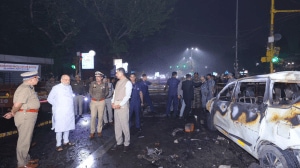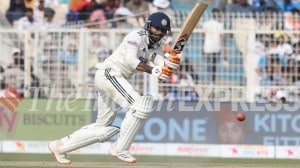Last week Prime Minister Narendra Modi was in the pilgrimage town of Dwarka, in Gujarat’s Devbhoomi Dwarka district, to inaugurate several infrastructural projects, including the Sudarshan Setu, India’s longest cable-stayed project connecting Okha town with the island of Beyt Dwarka.
“I spent those moments which will stay with me forever. I went into the deep sea and saw ancient Dwarika ji. Archeologists have written a lot about submerged Dwarika…While I was seeing Dwarikaji inside the sea, I was experiencing the same grandeur and divinity,” the PM said in his address later.
Story continues below this ad
Dwarka in mythology
Dwarka has immense significance in Hindu culture due to its association with Lord Krishna and the Mahabharata. It is believed that after killing his uncle Kamsa, Krishna migrated from Mathura to Dwarka with his Yadava clan, and founded his kingdom here by reclaiming 12 yojana land from the sea.
References in the Vishnu Purana suggest that Dwarka was a city of beautiful gardens, moats, ponds and palaces. The town, however, is believed to have been submerged under the sea after the death of Lord Krishna.
Locating Dwarka
Present-day Dwarka is a coastal town located at the mouth of the Gulf of Kutch, facing the Arabian Sea. The town is a part of the Krishna pilgrimage circuit, which includes Vrindavan, Mathura, Govardhan, Kurukshetra and Puri, and is home to the 13th-century Dwarkadheesh temple dedicated to Lord Krishna. There are a number of other places scattered along the Saurashtra coast that find a mention in legends associated with Lord Krishna, including Bet Dwarka and Mul Dwarka.
Since the beginning of the 20th century, multiple attempts have been made by scholars to establish the precise location of ‘Dwarka’ as mentioned in the Mahabharata. Most of these accounts, however, relied on ancient literature and works of other scholars.
Is it the same as present-day Dwarka? A town that possibly now lies under the sea? Or a mythological town whose historical authenticity may never be established?
Story continues below this ad
As noted by Alok Tripathi, Additional Director General of the Archaeological Survey of India (ASI), in his paper, ‘Excavations at Dwarka-2007’ (2013), F E Pargiter, the British civil servant and orientalist who was judge at the Calcutta High Court in 1904, had in his translation of the Markandeya Purana suggested for the first time that Dwarka was located on the ‘Raivataka’, a mountain range mentioned in the Mahabharata, and which is believed to be the present-day Girnar hills in Junagadh, around 200 km away from Dwarka town.
Tripathi also quoted historian A S Altekar, who, in the 1920s, “discussed that modern Dwarka may not have been as old as 1200 BCE, but accepted that it had been submerged as mentioned in some ancient texts”.
Scholar A D Pulsakar in his 1943 essay, ‘Historicity of Krishna’, suggested that present-day Dwarka is the same as the one mentioned in the Mahabharata. Similar thoughts were expressed by archaeologist H D Sankalia in the 1960s.
Archaeological findings on land
From the 1960s onwards, attention shifted from ancient literature to finding material evidence for the existence of Lord Krishna’s Dwarka.
Story continues below this ad
While the early excavations focused on land around present-day Dwarka, as speculation over a submerged city heightened, later explorations were conducted under water.
The first excavation was carried out close to the Dwarkadheesh temple in 1963 by the Deccan College in Pune, in association with the Gujarat government’s Department of Archaeology. The excavation had to be carried out in a very limited area since the region around the temple is heavily populated. The excavations revealed that the place had been inhabited for the last 2,000 years. “These findings did not support the traditional identification with the legendary city, but inspired others to continue their quest and take up further studies,” wrote ASI ADG Tripathi.
In 1979, the ASI carried out a second round of excavations under the leadership of archaeologist S R Rao in the area around the Dwarkadheesh Temple during the development of the area.
Tripathi explained in his work that although no official report of this excavation was published, the brief review by the ASI Director-General at that time mentioned the finding of remains of three earlier temples and Lustrous Red Ware pottery that could be dated to mid-second millennium BCE.
Story continues below this ad
The underwater search
The findings triggered further interest around Dwarka and consequently led to speculations of a submerged ancient settlement.
For the next two decades, a long, archaeological quest was carried out by a team of marine archaeologists and scientists from the National Institute of Oceanography (NIO), a laboratory under the Council of Scientific and Industrial Research (CSIR), to find the ‘sunken’ city in the Arabian Sea.
Marine archaeologist Dr Sila Tripati, who was part of the NIO team from 1988 onwards, said that during the course of the underwater excavations, they found about “200 stone anchors, stone structures, stone sculptures, small pieces pottery, some pieces of marble statues, iron anchors and other metal objects”.
Talking to The Indian Express, Sila Tripati explained that the material found was dated by comparing them to the findings from nearby areas. “When it comes to the archaeological excavations in Dwarka, one needs to take into account the entire region that includes Bet Dwarka, Nageshwar, Pindara, Gopi Talab among others, all of which are located at a distance of less than 30 kilometres from the town of Dwarka,” he said.
Story continues below this ad
“During our excavations and explorations at Bet Dwarka, on one side of the island we found evidence dating to the early historical period (from sixth century BCE to sixth century CE). On the other side of Bet Dwarka island, we found evidence from the late Harappan period (approximately 1900 to 1300 BCE). Since the stone anchors found underwater at Dwarka were similar to the Late Harappan findings at Bet Dwarka, we concluded that they were from the same period,” he stated, before underlining that most scholars agree that the Late Harappan era was the period of the Mahabharata.
ASI’s Alok Tripathi, however, suggested in his paper that the findings of the NIO, despite generating a lot of public interest, lacked clarity.
Consequently, between 2005 and 2007, another round of underwater excavations was carried out, this time by the Underwater Archaeology Wing (UAW) of the ASI, which was led by Alok Tripathi.
The underwater excavations, however, revealed that the structural remains found scattered on the sea bed were not in situ, but transported by waves and current. In other words, the artefacts were lying exposed and not buried deep and undisturbed for thousands of years. Consequently, it was not possible to assign a specific date to them.
The search continues.







































